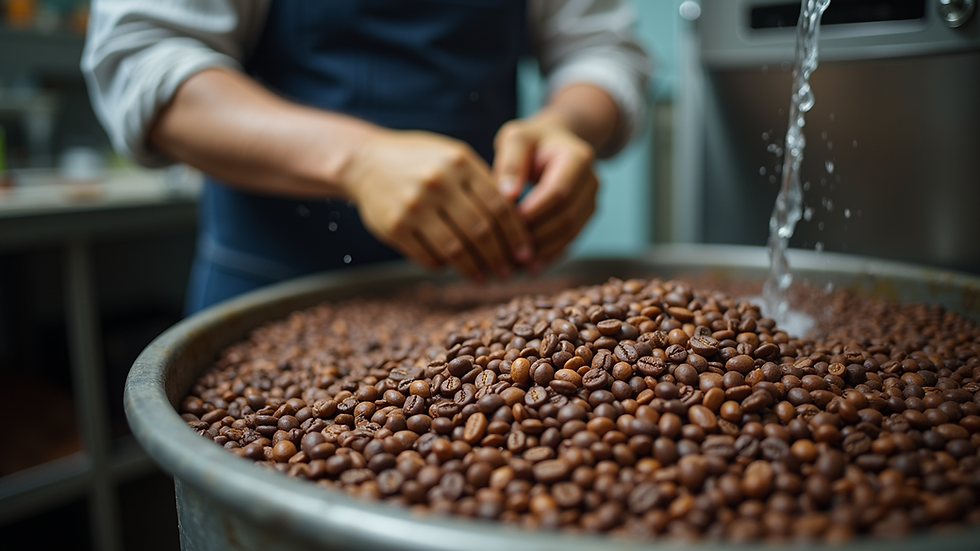Exploring Coffee Processing Methods: A Balanced Look at Their Pros and Cons
- lilybscoffeecart
- Jul 18
- 4 min read
Coffee fuels millions of mornings around the globe, but the path from coffee cherry to coffee cup is often overlooked. Understanding how coffee is processed can transform your appreciation for this beloved beverage. Each processing method showcases different taste profiles, and knowing their benefits and drawbacks can help you make informed choices. We will explore seven common coffee processing methods: washed, natural, honey, anaerobic, double fermentation, sun-drying, and raised bed drying. By the end, you will have a clearer picture of how these methods impact the flavor in your cup.
Washed Processing
Washed processing, also known as wet processing, removes the coffee cherry's outer pulp before fermentation. The beans are soaked in water, allowing the mucilage to break down before being washed clean.
Pros
Clarity of Flavor: Coffees from this method are typically bright and clean, making them ideal for regions like Central America, where varieties such as Costa Rican coffee can exhibit citrus notes and vibrant acidity.
Consistency: Controlled fermentation leads to a flavor profile that is more consistent. For instance, Colombian washed coffees often taste similar from batch to batch.
Cons
Water Usage: This method requires vast amounts of water. For example, producing one ton of coffee can use about 4,000 gallons of water. This raises environmental concerns, particularly in regions facing drought.
Labor Intensive: The meticulous nature of washed processing can make it more labor-intensive than other methods.

Natural Processing
Natural processing, or dry processing, is one of the oldest methods of coffee processing. This technique involves drying the whole cherry under the sun without removing the pulp.
Pros
Fruit Forward Flavors: This method often results in coffees that burst with fruity complexity. Ethiopian coffees processed this way can have berry-like notes and a syrupy sweetness.
Simplicity: Natural processing is straightforward and requires less technical equipment than washed processing, making it accessible to more producers.
Cons
Inconsistency: Uneven drying can lead to quality variations. In Brazil, defects like black beans can be more prevalent due to this method.
Fermentation Risks: If not monitored closely, beans can develop undesirable off-flavors from over-fermentation.

Honey Processing
Honey processing blends aspects of both washed and natural methods. Some mucilage remains on the beans during drying, creating a unique flavor profile.
Pros
Balance of Flavors: The result is often a coffee that combines the brightness of washed beans with the sweetness typically found in natural beans. For example, coffees from Costa Rica processed this way can exhibit a pleasant tartness balanced by honey-like sweetness.
Versatility: The level of mucilage left on the beans can be adjusted, allowing for a spectrum of flavors. Producers can fine-tune this balance to create coffees that appeal to a wide audience.
Cons
Processing Control: Honey processing demands careful monitoring of drying conditions as mucilage can introduce complications if moisture levels are not managed.
Potential for Variation: The final flavor profile may differ significantly from batch to batch, which can be a gamble for consumers seeking consistency.
Anaerobic Processing
Anaerobic processing involves fermenting coffee beans in sealed environments without oxygen. This method can lead to exciting and unique flavor developments.
Pros
Uniqueness in Flavor: Anaerobic fermentation can produce complex flavors, like floral notes mixed with chocolate. Some Guatemalan coffees using this method have gained attention for their bold taste profiles.
Innovation: This method allows producers to highlight local characteristics and experiment more freely with flavors.
Cons
Risk of Off-Flavors: If fermentation is poorly controlled, resulting flavors may be unappealing. Sampling anaerobically processed beans is essential to avoid unpleasant surprises.
Less Familiarity: As a newer method, not everyone may appreciate these distinct flavors, which can make it less popular among traditional coffee drinkers.
Double Fermentation
Double fermentation intensifies the anaerobic process by allowing two stages of fermentation, potentially enhancing flavor complexity even further.
Pros
Deep Flavor Profiles: This method can yield rich and layered coffees, perfect for enthusiasts looking for something extraordinary. Some experimental producers have seen success with flavors reminiscent of dark fruit and spice.
Innovation: It creates additional opportunities for flavor experimentation, attracting coffee connoisseurs who seek unique tasting experiences.
Cons
Labor and Time-Consuming: The double fermentation process can be time-intensive and may require more resources, impacting overall efficiency.
Limited Availability: Not all producers can employ this method due to its complexity, potentially limiting access for consumers.
Sun-Drying
Sun-drying is a classic method where beans or parchment are laid out in the sun to dry. This is highly effective in regions with lots of sun, like Tanzania.
Pros
Reduced Costs: Relying on sunlight reduces costs and is a more environmentally friendly option compared to water-intensive methods.
Natural Flavor Development: Beans can develop a naturally sweet and balanced flavor, which is often loved by fans of the traditional coffee taste.
Cons
Weather Dependent: Sun-drying relies heavily on consistent weather conditions. In years with excessive rain, producers may struggle with drying quality.
Risk of Contamination: Beans drying exposed can attract pests or experience contamination from airborne impurities.

Raised Bed Drying
In raised bed drying, beans are placed on elevated surfaces to facilitate better air circulation while drying. This method is especially prevalent in regions like Colombia.
Pros
Improved Airflow: Elevated beds enhance airflow, promoting even drying and better flavor retention. This can lead to high-quality beans that stand out in taste tests.
Quality Control: Producers can monitor drying conditions more effectively, reducing risks related to defects.
Cons
Higher Initial Costs: Setting up raised beds can require significant investment, making it difficult for smaller producers to adopt this method.
Limited Space: Some coffee producers may lack the land needed to utilize raised beds effectively, limiting this method’s practical application.
Final Thoughts on Coffee Processing
Understanding how coffee is processed significantly impacts the flavor and quality of your cup. Each processing method comes with its unique advantages and challenges. The choice of process not only affects the taste but also reflects the traditions and practices of coffee producers from various regions. By learning about these methods, coffee lovers can deepen their connection with this beverage and truly appreciate the complex flavors in every sip.



Comments